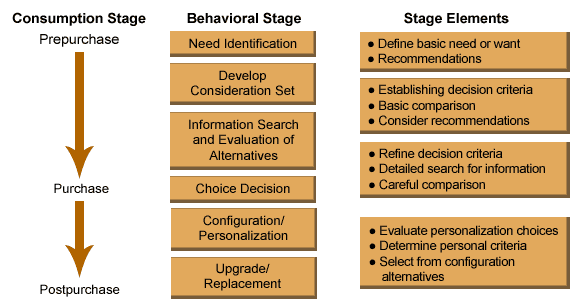


Page 5/6 |
Pre-Purchase
No matter how large or small the purchase, consumers go through the same purchase-decision process. The process starts with the pre-purchase steps, followed by the actual purchase, and finally by the post-purchase steps. Figure 2.1 illustrates this purchase-decision process:

Figure 2.1: The Consumer Purchase Decision Process
All purchases begin with an awareness of a basic need or want. Consumers then establish their decision criteria and refine the need or want. This process may be quick and simple (such as in choosing a soft-drink) or it may be time consuming and complicated (such as in choosing, comparing and researching automobiles). In the prepurchase stage, consumers often seek opinions and recommendations from other people and sources.
During the prepurchase stage, the customer chooses a Web site, searches for a product or service and makes a decision about whether or not to make a purchase. This decision is based on the usability of the home page and other Web pages of this site, information provided about the product or service, the price, the credibility of the Web site, the delivery mechanisms and refunds policy, etc.
A consumer's decision is based partly on value, quality and price of the product and partly on the policies and procedures of the e-tailer. Remember that return or shipping policies may be equally as important as your product price. Also recognize that some customers are just curious and may not buy. The right information on a Web site, especially geared to the skeptical customer, may help convert curiosity into a sale. Provide honest information about your product or service and basic information for the person new to your product (perhaps explaining basic terminology in a glossary).
Page 5/6 |
Web site and all contents © Copyright SRDC 2010, All rights reserved. |
|
| These materials were developed as part of the Southern Rural Development Center’s Nationall e-Commerce Extension Initiative. They are based upon work supported by the Cooperative State Research, Education, and Extension Service, U.S. Department of Agriculture, under Award No. 2005-45064-03212 Any opinions, findings, conclusions, or recommendations expressed in this publication are those of the author(s) and do not necessarily reflect the view of the U.S. Department of Agriculture or the Southern Rural Development Center. |
|